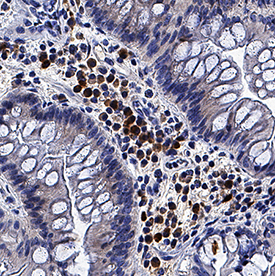Human 4-1BB Ligand/TNFSF9 Antibody
Human 4-1BB Ligand/TNFSF9 Antibody Summary
Arg71-Glu254
Accession # P41273.1
Applications
Please Note: Optimal dilutions should be determined by each laboratory for each application. General Protocols are available in the Technical Information section on our website.
Scientific Data
 View Larger
View Larger
4‑1BB Ligand/TNFSF9 in Human Crohn's Disease Intestine. 4-1BB Ligand/TNFSF9 was detected in immersion fixed paraffin-embedded sections of human Crohn's disease intestine using Rabbit Anti-Human 4-1BB Ligand/TNFSF9 Monoclonal Antibody (Catalog # MAB22951) at 3 µg/mL overnight at 4 °C. Before incubation with the primary antibody, tissue was subjected to heat-induced epitope retrieval using Antigen Retrieval Reagent-Basic (Catalog # CTS013). Tissue was stained using the Anti-Sheep HRP-DAB Cell & Tissue Staining Kit (brown; Catalog # CTS019) and counterstained with hematoxylin (blue). Specific staining was localized to cytoplasm. View our protocol for Chromogenic IHC Staining of Paraffin-embedded Tissue Sections.
Reconstitution Calculator
Preparation and Storage
- 12 months from date of receipt, -20 to -70 °C as supplied.
- 1 month, 2 to 8 °C under sterile conditions after reconstitution.
- 6 months, -20 to -70 °C under sterile conditions after reconstitution.
Background: 4-1BB Ligand/TNFSF9
4-1BB Ligand (4-1BBL; also CD137L) is a 32 kDa type II transmembrane protein that belongs to the TNF superfamily (TNFSF) molecules (1‑4). The human 4-1BBL cDNA encodes a 254 amino acid (aa) protein that contains a 25 aa N-terminal cytoplasmic domain, a 23 aa transmembrane segment, and a 206 aa C-terminal extracellular region (5). The extracellular domain (ECD) of 4-1BBL has a jelly-roll, beta -sandwich tertiary structure that is similar to other TNFSF members. There is only one cysteine in the human ECD, and no potential N-linked glycosylation sites. The potential exists, however, for O-linked glycosylation. The human 4-1BBL ECD shares 32% and 35% aa identity with mouse and rat ECD, respectively. In the cytoplasmic domain, human 4-1BBL is 55 aa shorter than the equivalent region in rodents. 4-1BBL is expressed by activated B cells, macrophages, dendritic cells, activated T cells, neurons and astrocytes (2, 3, 6). A bioactive 26 kDa soluble form of 4-1BBL, presumably generated by MMP cleavage, occurs in humans (4). Human 4-1BBL signals through both CD137/4-1BB and itself. Its cytoplasmic tail participates in reverse signaling that induces apoptosis in T cells and cytokine secretion (IL-6; TNF-alpha ) by monocytes (7, 8). 4-1BBL binding to CD137/4-1BB produces a number of effects. It seems to play a key role in the T cell recall response. It maintains T cell numbers at the end of a primary response, and induces CD4+ and CD8+ T cells to proliferate and secrete cytokines such as IL-2 and IFN-gamma in CD4+ cells, and IFN-gamma in CD8+ cells (9, 10).
- Kwon, B. et al. (2003) Exp. Mol. Med. 35:8.
- Salih, H.R. et al. (2002) Int. J. Clin. Pharmacol. Ther. 40:348.
- Vinay, D.S. and B.S. Kwon (1998) Semin. Immunol. 1:481.
- Salih, H.R. et al. (2001) J. Immunol. 167:4059.
- Alderson, M.R. et al. (1994) Eur. J. Immunol. 24:2219.
- Reali, C. et al. (2003) J. Neurosci. Res. 74:67.
- Michel, J. et al. (1999) Immunology 98:42.
- Langstein, J. et al. (1998) J. Immunol. 160:2488.
- Wen, T. et al. (2002) J. Immunol. 168:4897.
- Dawicki, W. and T.H. Watts (2004) Eur. J. Immunol. 34:743.
Product Datasheets
FAQs
No product specific FAQs exist for this product, however you may
View all Antibody FAQsReviews for Human 4-1BB Ligand/TNFSF9 Antibody
There are currently no reviews for this product. Be the first to review Human 4-1BB Ligand/TNFSF9 Antibody and earn rewards!
Have you used Human 4-1BB Ligand/TNFSF9 Antibody?
Submit a review and receive an Amazon gift card.
$25/€18/£15/$25CAN/¥75 Yuan/¥1250 Yen for a review with an image
$10/€7/£6/$10 CAD/¥70 Yuan/¥1110 Yen for a review without an image


